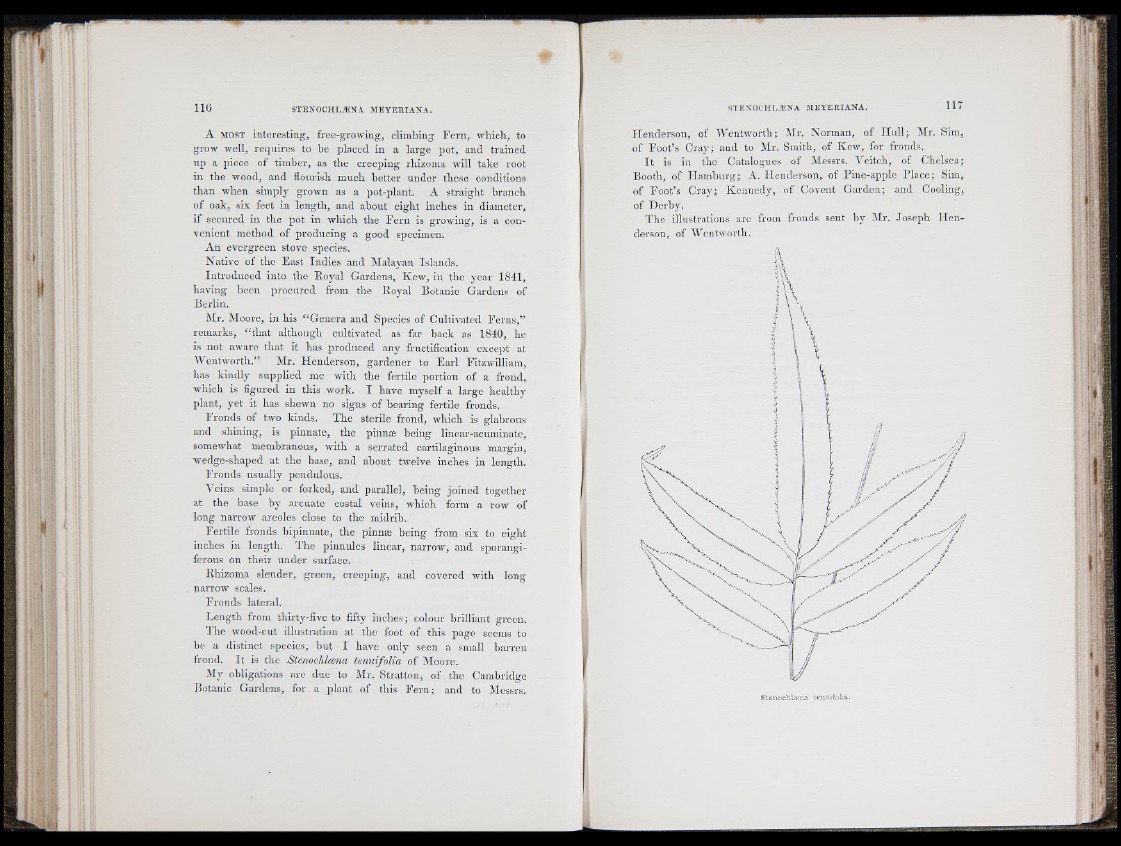
A MOST intere stin g , free-growing, climbing F e rn , which, to
groAY well, requires to he placed in a large pot, and tra in ed
up a piece of timber, as th e c reeping rhizoma will take root
in the wood, and flourish much b e tte r u n d e r these conditions
than when simply grown as a pot-plant. A stra ig h t bran ch
of oak, six feet in len g th , and about eig h t inches in diameter,
if secured in the p o t in which th e F e rn is growing, is a convenient
method of prod u c in g a good specimen.
A n evergreen stove species.
N a tiv e of the F a s t In d ie s and Malayan Islands.
In tro d u c e d in to the E o y a l Gardens, K ew , in the year 1841,
having been p ro cu red from th e Koyal Botanic Gardens of
Be rlin.
Mr. Moore, in his “ G en e ra and Species of Cultivated F e rn s ,”
remarks, “ th a t although cultivated as far hack as 1840, he
is not aware th a t it has p ro d u c ed any fructification except at
AVentw'orth.” Mr. H en d e rso n , g a rd en e r to F a i l Fitzwilliam,
has k in d ly supplied me with th e fertile portion of a frond,
which is figured in this work. I have myself a large healthy
p lan t, y e t it has shewn no signs of b earing fertile fronds.
Fro n d s of two kinds. T h e sterile frond, which is glabrous
and shining, is p in n a te , the pinnæ being linear-acuminate,
somewhat membranous, with a se rra ted cartilaginous margin,
wedge-shayied at th e base, and about twelve inches in length.
F ro n d s usua lly pendulous.
Veins simple or forked, and pa ra lle l, being jo in e d together
at the base by arcuate costal veins, which form a row of
long narrow areoles close to the midrib.
F e rtile fronds b ip in n a te , the pinnæ being from six to eight
inches in length. T h e pinnules linear, n arrow, and sporangi-
ferous on th e ir u n d e r surface.
Ehizoma slender, g re en , creeping, and covered with long
narrow scales.
F ro n d s lateral.
L en g th from thirty-five to fifty inches ; colour b rillian t green.
T h e wood-cut illustration at th e foot of this page sconis to
be a distinct species, b u t I have only seen a small b a rre n
frond. I t is the Stcnoclilæna tenuifolia of Moore.
My obligations arc duo to Mr. Stra tto n , of th e Cambridge
Botanic Gardens, for a plan t of this F e rn ; and to Messrs.
H en d e rso n , of AVentworth; Mr. Norman, of H u ll; Mr. Sim,
of F o o t’s C ray ; and to Mr. Smith, of Kew, for fronds.
I t is in the Catalogues of Messrs. Veitch, of Chelsea;
Booth, of H am b u rg ; A. H en d e rso n , of P ine-apple P la c e ; Sim,
of F o o t’s C ray ; K en n ed y , of Coveiit G a rd en ; and Cooling,
of D erby.
T h e illustrations arc from fronds sent b y Mr. Josep h H e n derson,
of AVentworth.
f
I
f r
A